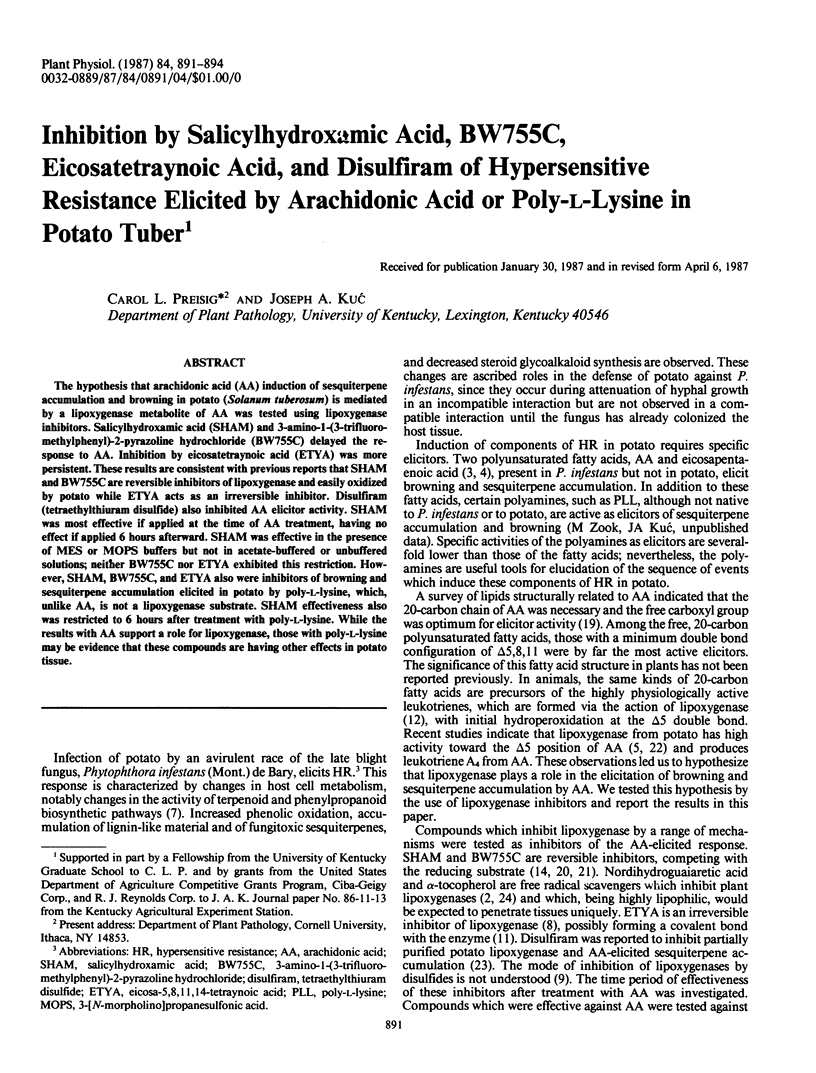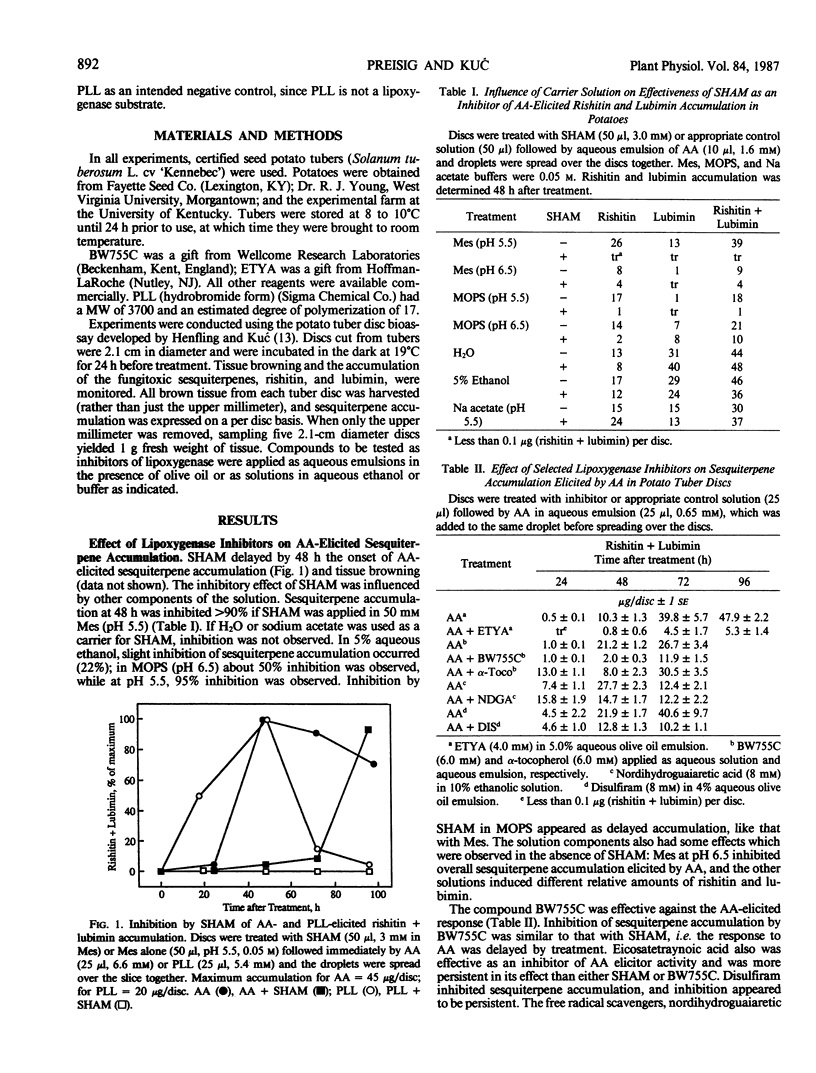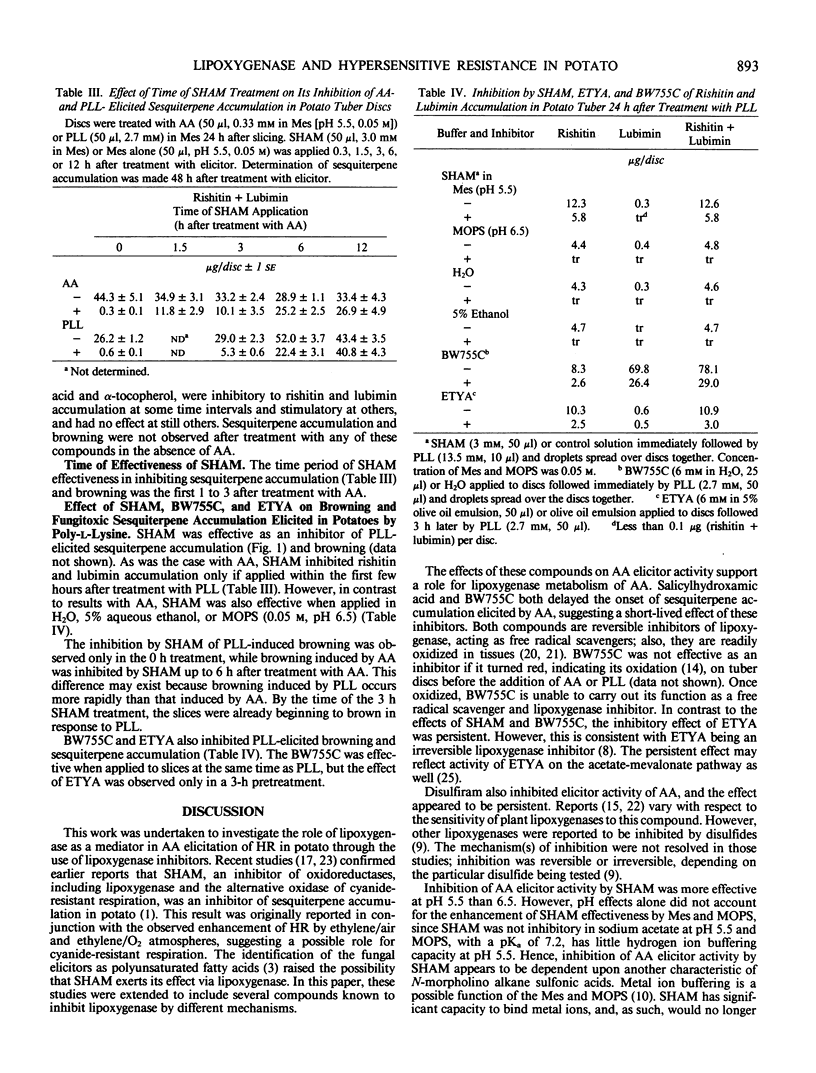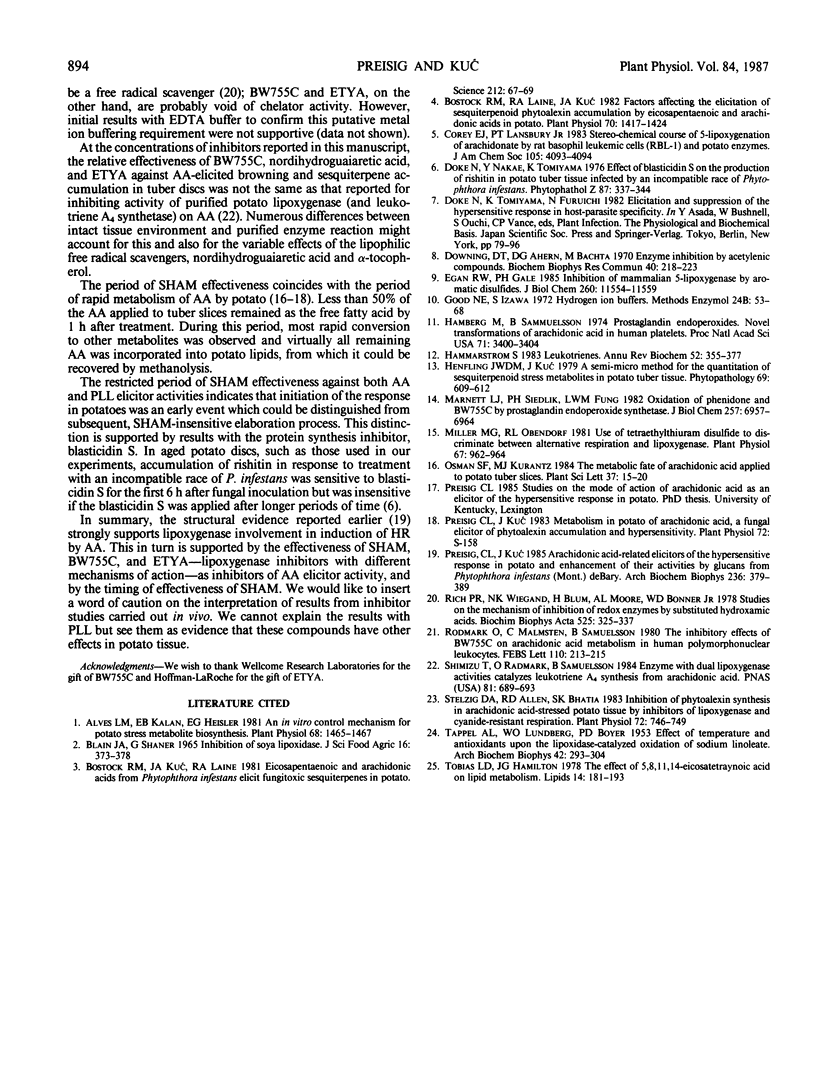Abstract
The hypothesis that arachidonic acid (AA) induction of sesquiterpene accumulation and browning in potato (Solanum tuberosum) is mediated by a lipoxygenase metabolite of AA was tested using lipoxygenase inhibitors. Salicylhydroxamic acid (SHAM) and 3-amino-1-(3-trifluoromethylphenyl)-2-pyrazoline hydrochloride (BW755C) delayed the response to AA. Inhibition by eicosatetraynoic acid (ETYA) was more persistent. These results are consistent with previous reports that SHAM and BW755C are reversible inhibitors of lipoxygenase and easily oxidized by potato while ETYA acts as an irreversible inhibitor. Disulfiram (tetraethylthiuram disulfide) also inhibited AA elicitor activity. SHAM was most effective if applied at the time of AA treatment, having no effect if applied 6 hours afterward. SHAM was effective in the presence of MES or MOPS buffers but not in acetate-buffered or unbuffered solutions; neither BW755C nor ETYA exhibited this restriction. However, SHAM, BW755C, and ETYA also were inhibitors of browning and sesquiterpene accumulation elicited in potato by poly-l-lysine, which, unlike AA, is not a lipoxygenase substrate. SHAM effectiveness also was restricted to 6 hours after treatment with poly-l-lysine. While the results with AA support a role for lipoxygenase, those with poly-l-lysine may be evidence that these compounds are having other effects in potato tissue.
Full text
PDF



Selected References
These references are in PubMed. This may not be the complete list of references from this article.
- Alves L. M., Kalan E. B., Heisler E. G. An in vitro control mechanism for potato stress metabolite biosynthesis. Plant Physiol. 1981 Dec;68(6):1465–1467. doi: 10.1104/pp.68.6.1465. [DOI] [PMC free article] [PubMed] [Google Scholar]
- Bostock R. M., Kuc J. A., Laine R. A. Eicosapentaenoic and Arachidonic Acids from Phytophthora infestans Elicit Fungitoxic Sesquiterpenes in the Potato. Science. 1981 Apr 3;212(4490):67–69. doi: 10.1126/science.212.4490.67. [DOI] [PubMed] [Google Scholar]
- Bostock R. M., Laine R. A., Kuć J. A. Factors affecting the elicitation of sesquiterpenoid phytoalexin accumulation by eicosapentaenoic and arachidonic acids in potato. Plant Physiol. 1982 Nov;70(5):1417–1424. doi: 10.1104/pp.70.5.1417. [DOI] [PMC free article] [PubMed] [Google Scholar]
- Downing D. T., Ahern D. G., Bachta M. Enzyme inhibition by acetylenic compounds. Biochem Biophys Res Commun. 1970 Jul 13;40(1):218–223. doi: 10.1016/0006-291x(70)91069-7. [DOI] [PubMed] [Google Scholar]
- Egan R. W., Gale P. H. Inhibition of mammalian 5-lipoxygenase by aromatic disulfides. J Biol Chem. 1985 Sep 25;260(21):11554–11559. [PubMed] [Google Scholar]
- Good N. E., Izawa S. Hydrogen ion buffers. Methods Enzymol. 1972;24:53–68. doi: 10.1016/0076-6879(72)24054-x. [DOI] [PubMed] [Google Scholar]
- Hamberg M., Samuelsson B. Prostaglandin endoperoxides. Novel transformations of arachidonic acid in human platelets. Proc Natl Acad Sci U S A. 1974 Sep;71(9):3400–3404. doi: 10.1073/pnas.71.9.3400. [DOI] [PMC free article] [PubMed] [Google Scholar]
- Hammarström S. Leukotrienes. Annu Rev Biochem. 1983;52:355–377. doi: 10.1146/annurev.bi.52.070183.002035. [DOI] [PubMed] [Google Scholar]
- Marnett L. J., Siedlik P. H., Fung L. W. Oxidation of phenidone and BW755C by prostaglandin endoperoxide synthetase. J Biol Chem. 1982 Jun 25;257(12):6957–6964. [PubMed] [Google Scholar]
- Miller M. G., Obendorf R. L. Use of Tetraethylthiuram Disulfide to Discriminate between Alternative Respiration and Lipoxygenase. Plant Physiol. 1981 May;67(5):962–964. doi: 10.1104/pp.67.5.962. [DOI] [PMC free article] [PubMed] [Google Scholar]
- Preisig C. L., Kuć J. A. Arachidonic acid-related elicitors of the hypersensitive response in potato and enhancement of their activities by glucans from Phytophthora infestans (Mont.) deBary. Arch Biochem Biophys. 1985 Jan;236(1):379–389. doi: 10.1016/0003-9861(85)90638-1. [DOI] [PubMed] [Google Scholar]
- Rich P. R., Wiegand N. K., Blum H., Moore A. L., Bonner W. D., Jr Studies on the mechanism of inhibition of redox enzymes by substituted hydroxamic acids. Biochim Biophys Acta. 1978 Aug 7;525(2):325–337. doi: 10.1016/0005-2744(78)90227-9. [DOI] [PubMed] [Google Scholar]
- Rådmark O., Malmsten C., Samuelsson B. The inhibitory effects of BW 755C on arachidonic acid metabolism in human polymorphonuclear leukocytes. FEBS Lett. 1980 Feb 11;110(2):213–215. doi: 10.1016/0014-5793(80)80075-5. [DOI] [PubMed] [Google Scholar]
- Shimizu T., Rådmark O., Samuelsson B. Enzyme with dual lipoxygenase activities catalyzes leukotriene A4 synthesis from arachidonic acid. Proc Natl Acad Sci U S A. 1984 Feb;81(3):689–693. doi: 10.1073/pnas.81.3.689. [DOI] [PMC free article] [PubMed] [Google Scholar]
- Stelzig D. A., Allen R. D., Bhatia S. K. Inhibition of phytoalexin synthesis in arachidonic Acid-stressed potato tissue by inhibitors of lipoxygenase and cyanide-resistant respiration. Plant Physiol. 1983 Jul;72(3):746–749. doi: 10.1104/pp.72.3.746. [DOI] [PMC free article] [PubMed] [Google Scholar]
- TAPPEL A. L., LUNDBERG W. O., BOYER P. D. Effect of temperature and antioxidants upon the lipoxidase-catalyzed oxidation of sodium linoleate. Arch Biochem Biophys. 1953 Feb;42(2):293–304. doi: 10.1016/0003-9861(53)90359-2. [DOI] [PubMed] [Google Scholar]
- Tobias L. D., Hamilton J. G. The effect of 5,8,11,14-eicosatetraynoic acid on lipid metabolism. Lipids. 1979 Feb;14(2):181–193. doi: 10.1007/BF02533870. [DOI] [PubMed] [Google Scholar]


